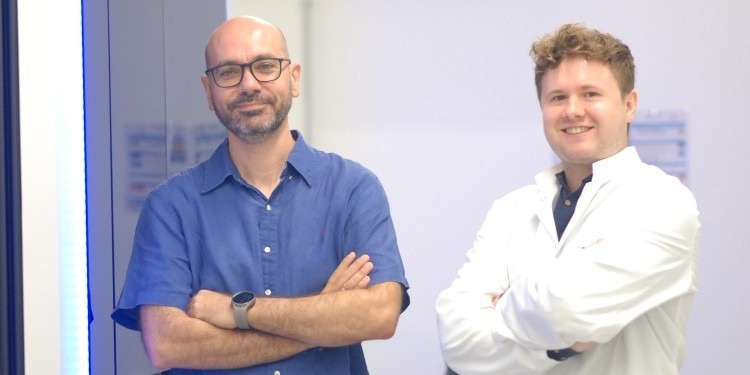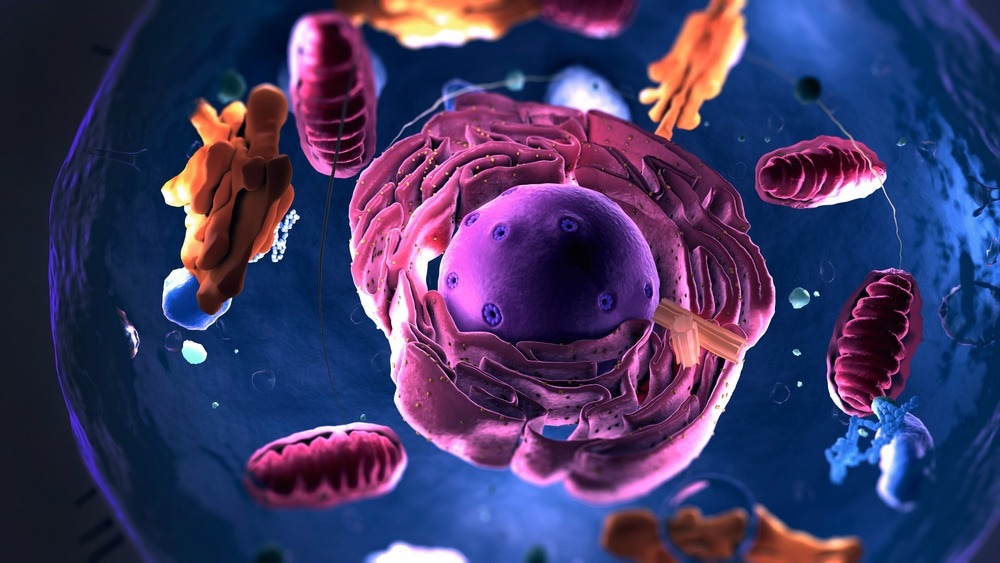Every system has a waste management system. The “peroxisomes” are cell organelles that dispose of toxic substances and lipids in the human body, among other things, and thereby avoid major diseases. The “Pex” set of proteins (peroxisomes biogenesis factors) keeps these “detox units” running smoothly.
 Taking a close look at peroxisomes: Prof. Dr. Christos Gatsogiannis and Maximilian Rüttermann. Image Credit: Karthik Subramaniam Kalyankumar
Taking a close look at peroxisomes: Prof. Dr. Christos Gatsogiannis and Maximilian Rüttermann. Image Credit: Karthik Subramaniam Kalyankumar
A team of Münster University researchers led by Prof. Christos Gatsogiannis has now become the first to illustrate, at the atomic level, how these very complicated processes work. The success story, which has recently been published in the journal Nature Communications, was made possible by the University’s new high-tech microscope.
We can imagine peroxisomes being like miniature factories which specialize in different tasks. First of all, they are known for ‘detoxifying’ the cell. They act as cellular waste disposal units in our cells.”
Christos Gatsogiannis, Professor, Institute for Medical Physics and Biophysics and Center for Soft Nanoscience (SoN), Münster University
This waste can be excess fatty acids or toxic substances from the environment: cell organelles as small as 0.5 micrometers (1 micrometer=1 millionth of a millimeter) handle at least 50 distinct operations of this kind.
Each of these processes necessitates the use of a unique set of enzymes. However, peroxisomes are bordered by a biological barrier through which proteins cannot easily pass, requiring them to be imported. This importing method requires energy in addition to another set of proteins known as the Pex group.

Image Credit: Christoph Burgstedt/Shutterstock.com
The role that peroxisomes perform in fat metabolism is very crucial for the system. This is because they not only break down fats, but also transform them into useful energy, which is required for a variety of functions in the body.
Without peroxisomes, hazardous amounts of particular fats can accumulate, causing major health consequences. This is why age-related disorders, such as loss of hearing or sight, Alzheimer’s, diabetes, or cancer, are frequently connected with peroxisomal anomalies.
Just like a truck, which transports products from one place to another, the transportation of enzymes requires a transportation protein, energy and well-thought-out logistics in order to work efficiently. And, again just like a truck, the protein is used again or recycled until ultimately it falls apart or disintegrates.”
Maximilian Rüttermann, PhD Student, Münster University
This recycling mechanism is the only one that uses a lot of energy during the full importing procedure. The peroxisomal AAA-ATPase complex Pex1/Pex6 plays the most important role: this “biological nanomachine” unpacks and unfolds the wasted proteins so that they can either be recycled or discarded. AAA-ATPases are essentially a cellular cleaning crew that maintains the cell’s inside clean, functioning, and ready for the rigors of life.
It is less surprising, however, that the majority of peroxisomal biogenesis errors are caused by mutations in Pex1 or Pex6, with up to 60% of all instances being caused by a rare genetic condition in which the patient’s cells are unable to produce peroxisomes.
The general public is unaware of this since patients affected usually die within a few days or weeks after birth–and there is no known remedy as of yet.
Gatsogiannis’ team of researchers has now demonstrated, for the first time in atomic detail, how the peroxisomal AAA-ATPase processes other enzymes to maintain the detox units running properly. The cryogenic electron microscopy approach was employed to accomplish this.
Rüttermann added, “Investigating a highly dynamic complex such as AAA-ATPase Pex1 Pex 6 is like watching a car engine running. You generate millions of images from all angles while it’s running and then, on this basis, produce a three-dimensional model in all its various states.”
In the spring of this year, the team installed a cutting-edge cryogenic electron microscope. The new 7.5-million-euro acquisition allows researchers to explore proteins and biological nanomachines at the atomic level, unlocking the secrets of how cells work.
The high-resolution structures demonstrate how the Pex1 and Pex6 proteins interact synchronously. They pull a substrate identical to the import receptors utilized for them to be recycled out of the membrane - a unique mechanism equivalent to a row of arms pulling a thick rope in pairs and untying its knots step by step.
Gatsogiannis concluded, “The atomic structures and an understanding of the mechanism of this complex nanomachine now enable us to understand important steps in peroxisome physiology in health and disease. It is now possible to relate all known mutations to their function, in order to understand their chemical consequences and, as a result, understand the causes of metabolic disorders.”
Source:
Journal reference:
Rüttermann, M., et al. (2023). Structure of the peroxisomal Pex1/Pex6 ATPase complex bound to a substrate. Nature Communications. doi.org/10.1038/s41467-023-41640-9